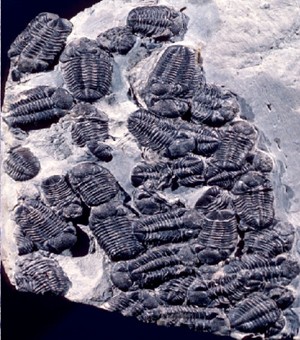
Fossils Record Ancient Migrations & Trilobite Orgies
Few specimens inspire greater thrills among fossil collectors than a complete trilobite. These ancient arthropods relatives of lobsters, spiders and insects went extinct more than 250 million years ago, but are sometimes found in beautifully preserved condition. In rare instances, an entire population of trilobites is found fossilized together. Carlton E. Brett finds evidence for ancient environment and behavior in these mass graves.
Brett, University of Cincinnati professor of geology, will present his findings March 20 at the Geological Society of America regional meeting in Pittsburgh, in a paper co-authored with Adrian Kin of Polands Institute of Geological Sciences at Jagiellonian University, and Brenda Hunda of the Cincinnati Museum Center.
In a quest that has taken him from Oklahoma to Morocco and Poland, Brett has analyzed multiple examples of mass trilobite burial. A smothering death by tons of hurricane-generated storm sediment was so rapid that the trilobites are preserved in life position. These geologic snapshots record behavior in much the way that ancient Roman life was recorded at Pompeii by volcanic ash.
Burial was rapid, Brett said, but also somewhat delicate. Trilobites, like other arthropods, shed their hard exoskeletons from time to time.

Trilobite migratory queue
We find molted pieces lying immediately adjacent to each other, he said. This is proof that the sediments were not significantly disturbed after burial.
Like modern crabs and lobsters, trilobites appear to have gathered in large groups for protection when they shed their protective exoskeletons. During molting, there was safety in numbers. And, like their modern cousins, trilobites seem to have used these molting gatherings as opportunities for mating.
The mass burials preserve large groups of similar-sized and therefore similarly aged specimens, segregated by species and, after molting, naked.
Its an orgy, Brett said.
Brett and colleagues found evidence of another behavioral connection to modern arthropods long chains of trilobites apparently fossilized in mid-migration.
The recent discovery of rows of more than a dozen specimens provides the oldest evidence of migratory queues similar to those seen in modern crustaceans, Brett said.
Taken together, the mass burials record an array of communal behaviors in ancient trilobites, comparable to those seen in some living crustaceans.
Such evidence points to complex synchronized escape and reproductive behavior, Brett said. This provides extraordinary insights into the paleobiology of these ancient organisms.
UC's paleontology program was again ranked sixth in the nation by U.S. News on March 15, 2011.
Related Stories
Alarming levels of bacteria found at Burnet Woods
April 25, 2025
UC Associate Professor Bob Hyland talks to WCPO about the latest findings of UC's environmental testing at Burnet Woods.
UC expert talks about excavating Pompeii
April 25, 2025
UC Classics Professor Steven Ellis talks to the podcast When in Rome about his excavations in the ancient Roman city of Pompeii, which was entombed in ash after the eruption of Mount Vesuvius.
UC prepares for another record commencement
April 25, 2025
The University of Cincinnati will celebrate another record spring commencement as undergraduate ceremonies return to Nippert Stadium.
